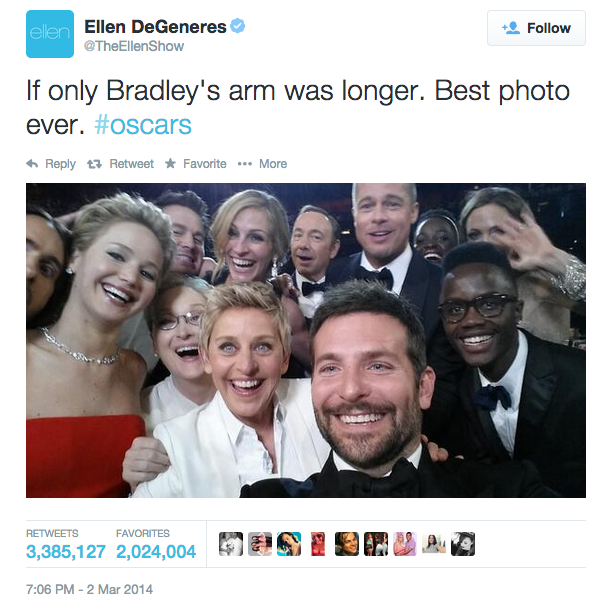Remember that time Ellen DeGeneres took a selfie at the 2014 Academy Awards? Of course you do.
Captured with sponsor Samsung’s Galaxy Note 3 smartphone, DeGeneres’ tweet crashed Twitter, and rightfully so, by getting more than 3.3 million retweets within a day—a record-breaking number. Sorry, Obama, but your “Four more years” re-election tweet can’t compete with this star-cladded Oscar selfie.
 Samsung should pat itself on its back—Publicis’ CEO Maurice Levy has valued DeGeneres’ selfie featuring A-list celebrities Bradley Cooper, Jennifer Lawrence, Julia Roberts, Meryl Streep and others—at an astounding $1 billion dollars (yes, you read that right). Samsung marketer Levy says the value is based on the tweet’s massive sharing and popularity on social media.
Samsung should pat itself on its back—Publicis’ CEO Maurice Levy has valued DeGeneres’ selfie featuring A-list celebrities Bradley Cooper, Jennifer Lawrence, Julia Roberts, Meryl Streep and others—at an astounding $1 billion dollars (yes, you read that right). Samsung marketer Levy says the value is based on the tweet’s massive sharing and popularity on social media.
Samsung capitalized on the post’s viral success by announcing that it’ll donate $1 to charity for each retweet it received. To this day, there’s still debate over whether the selfie was a paid stunt or an act of spontaneity. Although Samsung sponsored the Oscars, the fact the tweet was seemingly “organic” is major news. Whatever the case may be, it goes to show that social media buzz can be still created surrounding an event without resorting to the “Promoted Tweet” option.
Even though it’s “just” a selfie, DeGeneres’ tweet has proven to be a key lesson to marketers everywhere.
For one, we’ve learned the importance of having a varied digital marketing campaign that combines the elements of paid, earned and owned media. Ads have their place in social media marketing, but they aren’t always the most effective!
Marketers can also realize the significance of “spur-of-the-moment” situations. Even though Samsung sponsored the Oscars and had standard product placement of its smartphone throughout the ceremony, there is still an on-going debate whether the famous selfie was planned or not. Props to Samsung for playing it cool and effortlessly incorporating it into their marketing campaign (to all other other companies: take note).
Another takeaway is the fact that people are drawn to visual content. You want to ensure that the images you’re employing on social media channels are relatable to your target audience and interesting enough to spark engagement. Even Twitter enlarged photo and video previews in users’ timelines to account for this.
At the end of the day, however, the most important thing to remember is to stay authentic—nobody likes copycats! The last thing you want is for the public to bash you for using an obvious stunt to promote a product or get some press out of it. Brands that are trying to jump on the selfie bandwagon should recall that they have a lot to live up to if they decide to follow in Samsung’s steps.
